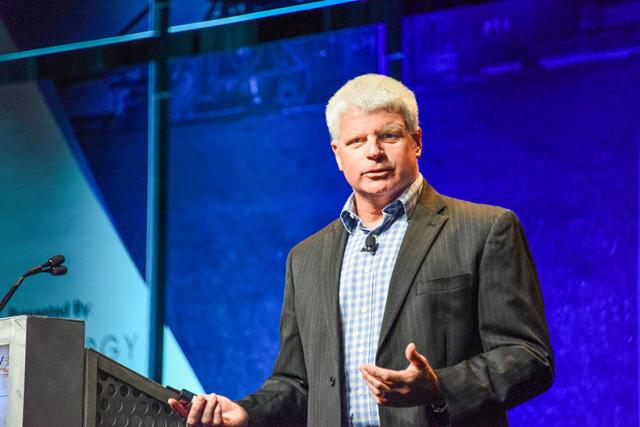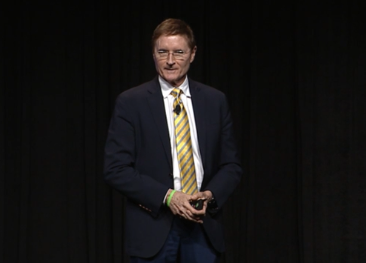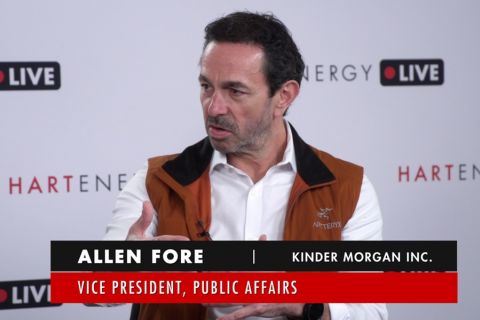
Frank McCorkle, founder and president of Treadstone Energy Partners, presents at Hart Energy's DUG Eagle Ford Conference & Exhibition in San Antonio. (Source: Steve Toon, Hart Energy)
SAN ANTONIO—Once described as the “most perverse, contrary, incorrigible oilfield known to man,” the Austin Chalk of east central Texas has perplexed, enticed and bewitched many into developing it. Faulty to a fault, the locating and producing of the formation’s ample resources has kept wildcatters busy since 1960, with the drilling of the discovery well in what would eventually become known as the Giddings Field. Stretching across multiple counties, the Giddings Field did not see large-scale development until the late 1970s.
“The field started out with vertical drilling, but the big increase in production came when horizontal drilling kicked in in the ’90s,” Phil Martin, CEO of New Century Exploration, told attendees at the recent Hart Energy DUG Eagle Ford Conference & Exhibition in San Antonio. “And it’s produced 300 MMbbl cumulative in its time, which at $50/bbl, that’s $15 trillion it’s generated. That’s an awful lot of money, and it’s mainly been technology-derived.”
Treadstone Energy Partners is adding barrels to that cumulative figure with its work in the area. Within the Giddings Field, tucked away near the convergence point of three counties—Burelson, Milam and Robertson—lies the Hearne Field. It is there that the company found what it considered the “perfect opportunity.”
“Our strategy is to research diligently for something that we believe everybody else is overlooking or misunderstands,” said Frank McCorkle, founder and president of Treadstone Energy Partners, in his presentation to DUG Eagle Ford attendees. “In 2016, we finally found an opportunity that met all of our acquisition criteria, and we were able to purchase the Hearne Field from Anadarko in the third quarter of 2016.”
The field ticked many of the “must have” boxes for Treadstone, including a 42,000 gross acre contiguous held-by-production position that is expandable, a stable production base of about 650 bbl/d and multiple development targets in the Austin Chalk, Eagle Ford and Buda Limestone formations, according to McCorkle.
The area has attracted billions in capital investments, with the purchase of Wildhorse Resources in October 2018 by Chesapeake Energy for $4 billion being one of the more recent acquisitions.
“The area is getting active. We have nine rigs currently running and oil production has been increasing a lot. The last couple of years it's reaching nearly 80,000 barrels a day,” he said.

Development of the Austin Chalk has evolved in its nearly six decades of production. McCorkle noted that in the late ’60s through the ’80s, the development of the Austin Chalk started with vertical wells and a large variety of completion techniques.
The drilling of open-hole single and multilateral horizontal wells began in the Chalk in the late ’80s, before transitioning to an approach using openhole packer systems with cased and cemented multistage stimulations in the mid-2010s.
“The Hearne Field was initially developed in the 1990s with widely spaced, openhole horizontal wells,” McCorkle said. “Since our acquisition, we have drilled 20 Austin Chalk wells to date.”
According to the presentation, legacy completions for the Hearne Field were multilateral/multireservoir open-hole horizontal commingled wells with small slickwater and sand fracture treatments. Subsequent water refacs showed significant bypassed oil and wellbore cleanouts showed a lack of long-term openhole integrity.
Treadstone developed a new completions plan using cased and cemented liner with electric submersible pump lift. Stages are spaced at 100 ft to 150 ft apart with an average fluid and proppant loading of 60-70 bbl/ft, 1,600 to 2,500 lb/ft, he noted.
“This type of completion is much more typical in other high-porosity resource plays, which is really what the Austin Chalk is in our area,” McCorkle said. “We used this completion technique because we were trying to access the matrix oil, that 8% plus porosity in this area in the unconnected natural fractures.”
The results of the company’s efforts are clear, as wells with the new completions type averaged 945 bbl/d, 30-day IP and 160,000 bbl cumulative at 10 months, according to the presentation.
“The initial uplift in performance is sustained over time. It isn’t just accessing refracs or a temporary rate acceleration,” McCorkle said. “It’s a significant incremental recovery from the Austin Chalk.”
Treadstone also is developing its Eagle Ford resources in the Hearne Field. The company’s Remi Rose 1HE, is a 10,000-ft lateral well drilled earlier this year.
“The well produced at least 1,300 bbl/d, average for the first 30 days,” he said. “And it has produced 128,000 bbl in its first six months. We’ve drilled five of these wells to date.”
Large slickwater completions have doubled the area’s Eagle Ford production of oil, the presentation noted.
“The change in the completion model, from 20 bbl/ft of fluid to 60 bbl/ft, from hybrid to slickwater, from about 1,000 lb/ft to more than 3,000 lb/ft of has lead to a more than twofold increase in the estimated recovery of these wells in this area,” he said.
Treadstone has increased Hearne Field production more than 16 times since acquiring the asset in 2016, he noted, with more than 10,000 bbl/d of production currently. To continue that momentum, the company plans to further increase its efficiency through the use of pad drilling while continuing to build-out infrastructure and development of the field.
Recommended Reading
The Jones Act: An Old Law on a Voyage to Nowhere
2024-04-12 - Keeping up with the Jones Act is a burden for the energy industry, but efforts to repeal the 104-year-old law may be dead in the water.
Kinder Morgan Exec: Building Pipelines ‘Challenging, but Manageable’
2024-04-05 - Allen Fore, vice president of public affairs for Kinder Morgan, said building anything, from a new road to an ice cream shop, can be tough but dealing with stakeholders up front can move projects along.
FERC Again Approves TC Energy Pipeline Expansion in Northwest US
2024-04-19 - The Federal Energy Regulatory Commission shot down opposition by environmental groups and states to stay TC Energy’s $75 million project.
CEO: Linde Not Affected by Latest US Green Subsidies Package Updates
2024-02-07 - Linde CEO Sanjiv Lamba on Feb. 6 said recent updates to U.S. Inflation Reduction Act subsidies for clean energy projects will not affect the company's current projects in the United States.
Global Energy Watch: Corpus Christi Earns Designation as America's Top Energy Port
2024-02-06 - The Port of Corpus Christi began operations in 1926. Strategically located near major Texas oil and gas production, the port is now the U.S.’ largest energy export gateway, with the Permian Basin in particular a key beneficiary.




